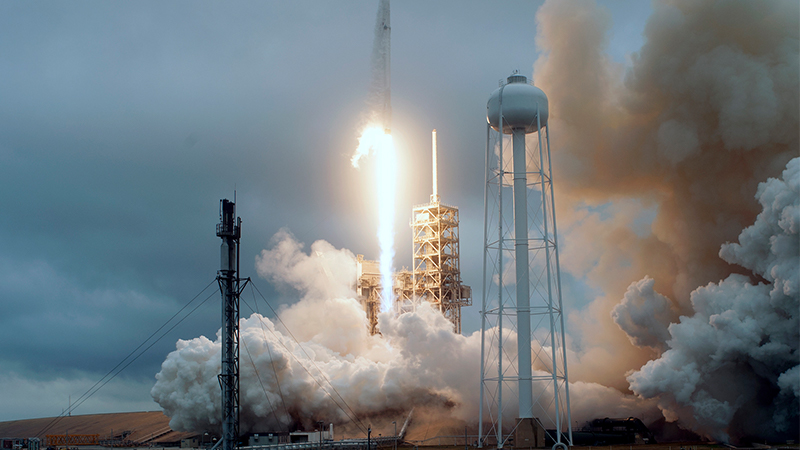From the Cape: Blogging about the Falcon 9 liftoff
By Hannah Godofsky|February 24, 2017
Hannah attended the Feb. 19 launch of a Dragon cargo capsule as a participant in the NASA Social program, in which selected social media outlets are invited to attend interesting events. Hannah manages AIAA’s social media channels.
NASA’s Kennedy Space Center is a place of historic importance due to its role in the Apollo and space shuttle programs, but a visit there today reveals an agency looking toward the future. I and other social media visitors for the SpaceX Dragon launch were invited to stand at a rope line across the massive doorframe of the famous Vehicle Assembly Building and peek inside.
When the VAB was built in the 1960s for the Apollo program, it was one of the largest buildings in the world. Even today it still stuns in its sheer enormousness and complexity. It has, however, been remodeled several times since it was built to fit the most modern of rockets. Today it is being renovated to accommodate the Space Launch System rockets and Orion crew modules.
Next, we were taken to a briefing site in front of the historic Launch Complex 39A. Most of the Apollo missions; assembly flights for the International Space Station and other space shuttle missions were launched from 39A. In 2014, SpaceX signed a 20-year lease with NASA to take over the pad. Now it has been refurbished for the SpaceX Falcon 9 and Falcon Heavy rockets. The highly anticipated launch I was there to attend would be the first for SpaceX at this most famous of NASA pads.
The next day bright and early we boarded the bus to head out to the launch viewing area near the famous NASA Kennedy countdown clock. If all went well, in only a few short hours we would watch a SpaceX Falcon 9 rocket lift off with a Dragon capsule packed with about 2,500 kilograms of experiments and supplies for the crew on the International Space Station.
Our tour guide told us that the clock at the launch pad is the second most photographed clock in the world, after Big Ben.
Emotions ran high as the weather seemed to be cooperating against all odds: Predicted thunderstorms turned into a cloudless sky and bright sun. But rumors of mechanical difficulties hung thick in the air in the NASA Social viewing area. Twitter was running wild with speculation. There was a helium leak! And a steering issue! Nobody seemed to be able to accurately pin down the seriousness of the rumored technical difficulties, or describe whether or not they had been solved.
And then, when the countdown clock stopped with only 13 seconds to go, there was a lot of sadness and frustration. Before we even got back on the bus, people were calling United or American Airlines to rebook their flights so they could see the next day’s launch attempt.
I had seen this show once already in a previous attempt to watch a SpaceX launch on a side trip made during AIAA SciTech in 2015 and knew not to get my hopes up too much. I knew all along it was far more likely to go on the second day.
A much smaller and more exhausted and jaded group assembled by the countdown clock again the next day, Feb. 19, for a second chance to see a launch. The incessant speculation about whether or not there would be a launch was traded for chatter about returning home. It was almost like people didn’t believe it would happen.
But then it did. It almost caught us off guard. “10… 9… 8… 7…” – for a moment, it looked as though nothing had happened, and people started to freak out. “Is it going to go? Is something wrong?”
And then it went. It was a cloudy day, so the view was a bit obstructed, but the roar of the Falcon 9 leaving the Earth drowned out the cheers of the crowd.
Then we traded one anxiety for another as we watched the horizon for any sign of the first stage of the SpaceX rocket returning to Earth. When it happened, we couldn’t see it, but we could hear the stage blast through the atmosphere to land back on a concrete pad near the water. The crowd roared with cheers as it became clear that everything had worked out and the launch was a success.
The International Space Station intercepted the capsule on Feb. 23, a day later than planned after one abandoned rendezvous attempt.
After attending a launch in person, I can’t begin to contemplate how stressful it must be for the team that gives the final go-ahead for a launch. NASA and SpaceX spent several years and many millions of dollars preparing 39A for this new use. The successful launch and the resulting sense of relief must have been overwhelming for the engineers that had worked on the mission or the scientists that sent their work to the ISS.






